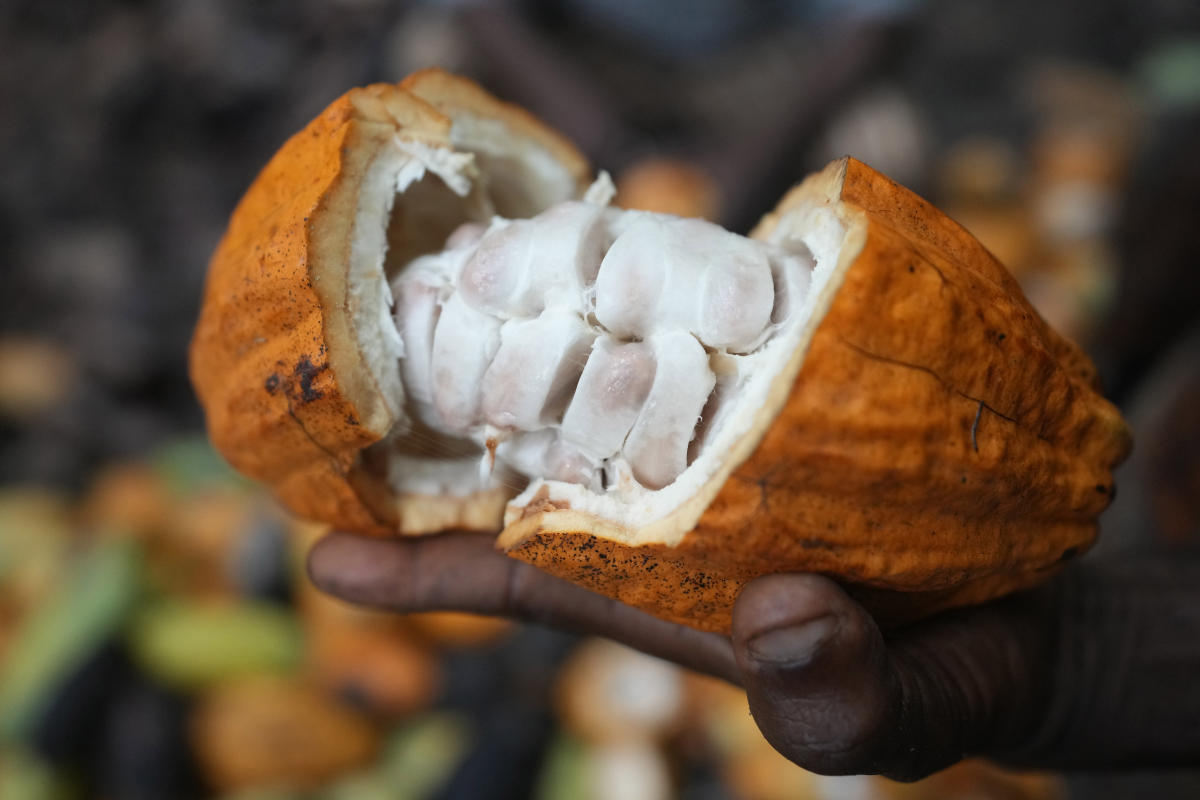DOS_patos
Unverified Legion of Trill member
Men in dusty workwear trudge through a thicket, making their way up a hill where sprawling plantations lay tucked in a Nigerian rainforest whose trees have been hacked away to make room for cocoa bound for places like Europe and the U.S.
Kehinde Kumayon and his assistant clear low bushes that compete for sunlight with their cocoa trees, which have replaced the lush and dense natural foliage. The farmers swing their machetes, careful to avoid the ripening yellow pods containing beans that will help create chocolate, the treat shoppers are snapping up for Christmas.
Over the course of two visits and several days, The Associated Press repeatedly documented farmers harvesting cocoa beans where that work is banned in conservation areas of Omo Forest Reserve, a protected tropical rainforest 135 kilometers (84 miles) northeast of the coastal city of Lagos in southwestern Nigeria.
Trees here rustle as dwindling herds of critically endangered African forest elephants rumble through. Threatened pangolins, known as armored anteaters, scramble along branches. White-throated monkeys, once thought to be extinct, leap from one tree to the next. Omo also is believed to have the highest concentration of butterflies in Africa and is one of the continent’s largest and oldest UNESCO Biosphere Reserves.
Cocoa from the conservation zone is purchased by some of the world’s largest cocoa traders, according to company and trade documents and AP interviews with more than 20 farmers, five licensed buying agents and two brokers all operating within the reserve.
They say those traders include Singapore-based food supplier Olam Group and Nigeria’s Starlink Global and Ideal Limited, the latter of which acknowledged using cocoa supplies from the forest. A fewer number of those working in the forest also mentioned Tulip Cocoa Processing Ltd., a subsidiary of Dutch cocoa trader and producer Theobroma.
Those companies supply Nigerian cocoa to some of the world’s largest chocolate manufacturers including Mars Inc. and Ferrero, but because the chocolate supply chain is so complex and opaque, it’s not clear if cocoa from deforested parts of Omo Forest Reserve makes it into the sweets that they make, such as Snickers, M&Ms, Butterfinger and Nutella. Mars and Ferrero list farming sources on their websites that are close to or overlap with the forest but do not provide specific locations.
The rest:

 www.yahoo.com
www.yahoo.com
Kehinde Kumayon and his assistant clear low bushes that compete for sunlight with their cocoa trees, which have replaced the lush and dense natural foliage. The farmers swing their machetes, careful to avoid the ripening yellow pods containing beans that will help create chocolate, the treat shoppers are snapping up for Christmas.
Over the course of two visits and several days, The Associated Press repeatedly documented farmers harvesting cocoa beans where that work is banned in conservation areas of Omo Forest Reserve, a protected tropical rainforest 135 kilometers (84 miles) northeast of the coastal city of Lagos in southwestern Nigeria.
Trees here rustle as dwindling herds of critically endangered African forest elephants rumble through. Threatened pangolins, known as armored anteaters, scramble along branches. White-throated monkeys, once thought to be extinct, leap from one tree to the next. Omo also is believed to have the highest concentration of butterflies in Africa and is one of the continent’s largest and oldest UNESCO Biosphere Reserves.
Cocoa from the conservation zone is purchased by some of the world’s largest cocoa traders, according to company and trade documents and AP interviews with more than 20 farmers, five licensed buying agents and two brokers all operating within the reserve.
They say those traders include Singapore-based food supplier Olam Group and Nigeria’s Starlink Global and Ideal Limited, the latter of which acknowledged using cocoa supplies from the forest. A fewer number of those working in the forest also mentioned Tulip Cocoa Processing Ltd., a subsidiary of Dutch cocoa trader and producer Theobroma.
Those companies supply Nigerian cocoa to some of the world’s largest chocolate manufacturers including Mars Inc. and Ferrero, but because the chocolate supply chain is so complex and opaque, it’s not clear if cocoa from deforested parts of Omo Forest Reserve makes it into the sweets that they make, such as Snickers, M&Ms, Butterfinger and Nutella. Mars and Ferrero list farming sources on their websites that are close to or overlap with the forest but do not provide specific locations.
The rest:

Cocoa grown illegally in a Nigerian rainforest heads to companies that supply major chocolate makers
Men in dusty workwear trudge through a thicket, making their way up a hill where sprawling plantations lay tucked in a Nigerian rainforest whose trees have been hacked away to make room for cocoa bound for places like Europe and the U.S. Kehinde Kumayon and his assistant clear low bushes that...
